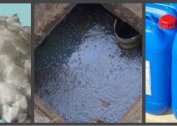The accumulation of sludge in a sewer pit often creates problems for owners of private houses and cottages. You can clean the waste tank in several proven ways. Some methods involve the implementation of do-it-yourself cleaning, while others involve the use of special devices or industrial facilities.
Symptoms of a Problem
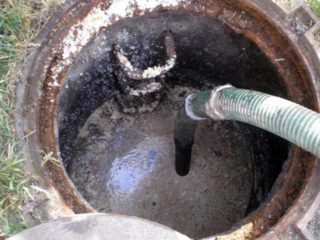 Siltation of the bottom of the cesspool and its quick filling often occurs due to the deposition of fat in the drains. Sewer waste in combination with cold water contributes to the thickening of fatty compounds, which clog the soil pores and drain the drain pit, as a result of which the water stops going into the soil.
Siltation of the bottom of the cesspool and its quick filling often occurs due to the deposition of fat in the drains. Sewer waste in combination with cold water contributes to the thickening of fatty compounds, which clog the soil pores and drain the drain pit, as a result of which the water stops going into the soil.
The main sign of a problem with sewage is a decrease in tank volume. The waste tank begins to fill up quickly, which leads to more frequent pumping of sewage waste. There is an unpleasant pungent odor due to disruption of the rotting process.
Dry cleaning
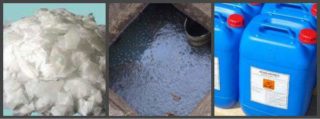 If the problem occurs in the winter, chemical preparations will help to eliminate it.
If the problem occurs in the winter, chemical preparations will help to eliminate it.
Their undeniable advantages:
- action in low temperature conditions;
- resistance to aggressive environment;
- ability to decompose different types of sewage;
- eliminate odor quickly.
The modern market offers a large number of nitrate oxidizing agents that are not harmful to the environment and human health. The mechanism of action of such chemicals is similar to the work of nitrate fertilizers, which allows the use of sewage waste to feed plant crops.
The use of nitrate oxidizing agents contributes to:
- rapid fat thinning:
- solid waste reduction:
- remove odor.
Cleaning the cesspool in this way does not require a large cash outlay.
The cleaning procedure is carried out in several stages:
- Measure the required amount of chemical in accordance with the instructions.
- Pour the product into the sewer tank and close it. The average duration of dilution and dissolution of waste is 3-6 hours.
- Sewer waste is pumped using a fecal or drainage pump.
- Wash the hole with clean water.
This method has some disadvantages that you should definitely pay attention to:
- They are not suitable for plastic barrels and septic tanks of an open design.
- The effectiveness of the drug increases gradually and depends on the frequency of its use.
- After the use of such preparations, it is not recommended to carry out cleaning with bioactivators for a long period, since chemical compounds contribute to the neutralization of bacteria.
Biological cleaning
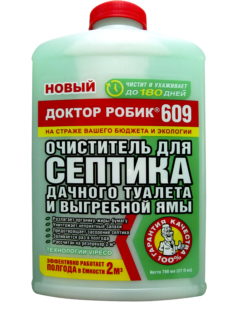 A good effect when removing sewage sludge is given by biological preparations. They include anaerobic and aerobic microorganisms that process sludge, fatty compounds and human waste.
A good effect when removing sewage sludge is given by biological preparations. They include anaerobic and aerobic microorganisms that process sludge, fatty compounds and human waste.
In specialized stores, a wide selection of products in the form of powder, tablets or liquid is presented. Among the advantages of such drugs:
- High efficiency, which reduces waste by 30%.
- Quick elimination of a characteristic smell.
- Harmless to human health and the environment.
- Suitability for both closed and open pits.
Biological cleaning is carried out according to the following scheme:
- Pour the required amount of biological substance into the sewer pit (recommended cleaning time is 7-10 days).
- Liquid waste is pumped out.
- Rinse with clean water under high pressure.
When cleaning the sewer pit in this way, the constant use of bacteria is also possible.For this, an additional portion of microorganisms is placed in the tank.
Drains for biological cleaning of the tank can also be used as fertilizers in the garden and in the garden.
Mechanical cleaning
It involves different ways to remove sewage sludge.
Manually
 The cesspool can be cleaned manually. Although the method is not easy and unpleasant - the result will be good. For cleaning use a shovel, a rope and special clothes and shoes.
The cesspool can be cleaned manually. Although the method is not easy and unpleasant - the result will be good. For cleaning use a shovel, a rope and special clothes and shoes.
Work sequence:
- Drain the waste tank using a bucket and rope.
- Having descended into the pit, they select the accumulated sludge with a shovel and with the help of a bucket on the cable lift it up.
This method is suitable for small sewer pits.
Pump
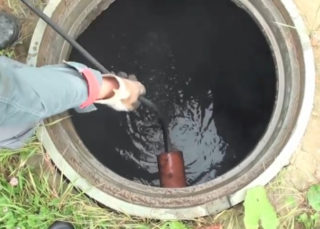 To remove sludge from the pit, perform the following actions:
To remove sludge from the pit, perform the following actions:
- Immerse the fecal or drainage pump at the very bottom or in the upper layer of the drain (depending on the type of technical device).
- From the sewer tank, a hose is pulled into the drain pit (optional).
- After the cleaning process is completed, mechanical removal of sludge and fat deposits from the bottom and walls is carried out. Use brushes made of metal and buckets.
- Pour pit with clean water.
- Repeated pumping and disposal of water.
To enhance the cleaning efficiency, chemicals are added to the cesspool.
Cesspool machine
For quick cleaning of the waste tank, they often use the services of wastewater. Professional machines are equipped with sludge pumps that make sludge deposits easy to remove.
This type of mechanical cleaning gives a good result. It can be used for containers made of concrete, metal and stone. Its main disadvantage is the lack of a long-term effect.
Problem prevention
In order to prevent siltation of the bottom of the sewage pit and reduce the number of cleanings, the following preventive measures are carried out:
- Sewer waste is pumped out of the cesspool in a timely manner.
- The walls and bottom are regularly washed with water under strong pressure.
- For the purpose of prevention in the summer, biological and chemical agents are used that prevent the formation of fat deposits in the sewer tank and help eliminate unpleasant odors.
If such measures are observed, then an autonomous sewage system will function reliably for a long time.


